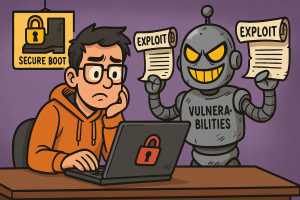 A new attack called Pixnapping can steal sensitive data from Android devices, without needing a single permission. The exploit targets visual data on-screen, including two-factor authentication codes, private messages, and location histories. It works by quietly measuring how long it takes to render specific pixels. If that sounds like science fiction, it’s not. Researchers have already tested it on Pixel and Samsung devices with unsettling results. [Read more…]
A new attack called Pixnapping can steal sensitive data from Android devices, without needing a single permission. The exploit targets visual data on-screen, including two-factor authentication codes, private messages, and location histories. It works by quietly measuring how long it takes to render specific pixels. If that sounds like science fiction, it’s not. Researchers have already tested it on Pixel and Samsung devices with unsettling results. [Read more…]
Microsoft Plugs One Secure Boot Flaw While Leaving Another Wide Open
 Security researchers have identified two major exploits in the Secure Boot system, both capable of sidestepping one of the most important protections on modern PCs. Microsoft has issued a patch for one of them. The other remains untouched, even as it offers attackers a nearly universal method to bypass security during the startup process.
Security researchers have identified two major exploits in the Secure Boot system, both capable of sidestepping one of the most important protections on modern PCs. Microsoft has issued a patch for one of them. The other remains untouched, even as it offers attackers a nearly universal method to bypass security during the startup process.
This week’s patch from Microsoft addresses a vulnerability known as CVE-2025-3052. It impacts over 50 manufacturers whose systems rely on Linux modules to support boot processes. The flaw allows someone with physical access to a device to disable Secure Boot entirely. Once that’s done, they can install malware that loads before the operating system starts. The attack is particularly concerning because it’s stealthy and persistent, and in cases where a hacker already has administrative access, it can be triggered remotely. [Read more…]